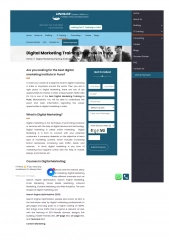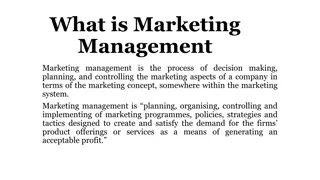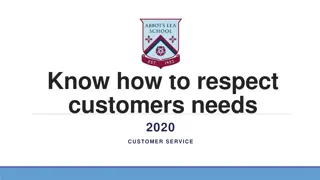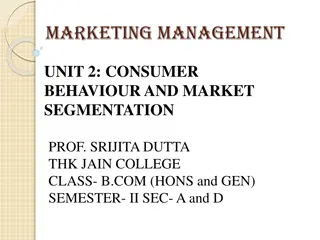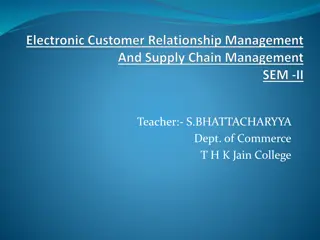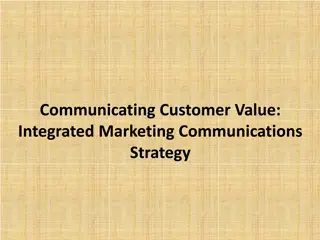Principles of Marketing and Building Customer Relationships
Marketing is a crucial management process that involves creating, communicating, delivering, and exchanging offerings to satisfy customer needs efficiently and profitably. It encompasses activities such as liaising with agencies, setting promotional objectives, conducting market analysis, and managing product portfolios. The concept of customer value, marketing activities, the 7 Ps of marketing, and the scope of marketing are also explored in this comprehensive study.
Download Presentation

Please find below an Image/Link to download the presentation.
The content on the website is provided AS IS for your information and personal use only. It may not be sold, licensed, or shared on other websites without obtaining consent from the author.If you encounter any issues during the download, it is possible that the publisher has removed the file from their server.
You are allowed to download the files provided on this website for personal or commercial use, subject to the condition that they are used lawfully. All files are the property of their respective owners.
The content on the website is provided AS IS for your information and personal use only. It may not be sold, licensed, or shared on other websites without obtaining consent from the author.
E N D
Presentation Transcript
Near East University Faculty Of Economics & Administrative Sciences MAN - 101 Introduction To Business Week 6 - Marketing Tu berk KAYA tugberk.kaya@neu.edu.tr
Principles of Marketing: Building Relationships with Customers for Competitive Advantage (Chp. 11, 12 13) Activities, a set of institutions, and process for creating, communicating, delivering, and exchanging offerings that have value for customers, clients, partners and society at large. Marketing is the management process which identifies, anticipates and supplies customer requirements efficiently and profitably. (Chartered Institute of Marketing) Marketing is a social and managerial process buy which individuals and groups obtain what they need and want through creating and exchanging products and value with others (Kotler et al. 2003)
Sources of customer value Information Convenience Association Added Value Value for money
Marketing activities Liaising with Agencies Recruiting and training staff Setting promotional objectives Designing promotional mix Marketing research Market analysis Setting strategy Planning Developing new products Managing product portfolios
Marketing activities contd. Managing and protecting brands Designing marketing channels Managing marketing channels Analysing competitor activity Managing customer service Ensuring customers are satisfied Evaluating and reviewing activities and plans
The 7 Ps of marketing Product - A bundle of benefits. Price - Total cost of acquiring the product. Place - The location where the exchange takes place. Promotion - All the communications activities of marketing. Advertising, Personal Selling, Sales Promotions, PR People - The individuals involved in facilitating the exchange process. Process - The set of activities which lead to delivery of the product benefits. Physical evidence Helps buyers make judgements
Scope of marketing Consumer marketing Industrial marketing Service marketing Not-for-profit marketing Small business marketing International marketing
Definition of Segmentation The identification of individuals or organisations with similar characteristics that have significant implications for the determination of marketing strategy.
The advantages of market segmentation Target market selection Tailored marketing mix Market segmentation Differentiation Opportunities and threats
The process of market segmentation & target marketing The disaggregated market market The segmented The target market 1 2 3 1 2 3 c1 c3 c2 c1 c5 c7 c3 c4 c8 c1 c5 c7 c3 c4 c8 c4 Marketin g mix targeted at segment 3 c2 c6 c2 c6 c6 c5 c7 c8 Customers are grouped into segments on the basis of having similar characteristics The characteristics of individual customers are understood Segment 3 is judged to be most attractive and a marketing mix strategy is designed for that target market
Segmenting consumer markets Consumer segmentation Profile Psychographic Behavioural Demographic Lifestyle Benefits sought Socio-economic Personality Purchase occasion Geographic Purchase behaviour Usage Perceptions and beliefs
Marketing communications are part of a changing world New World Old World Two-way Dialogue With Consumers Consumers Two-way Dialogue With Talking At Consumers Talking At Consumers Focus on Building Long Term Relationships With Consumers Consumers Focus on Building Long Term Relationships With Focus on Winning New Customers Customers Focus on Winning New Marketers Use and Coordinate Many Different Forms of Communication With Consumers Marketers Relied Primarily on Advertising and Promotions Promotions Marketers Relied Primarily on Advertising and
What is a brand? A product is anything that is capable of satisfying consumer needs. A brand gives a product a distinctive identity through the creation of a name, design or, more usually, some combination of these.
Categories, brands and variants Category Brand A Brand C Brand B Variants A1 A2 A3 Variants B1 B2 B3 Variants B1 B2 B3
Why strong brands are important 1. Consumer perceptions and preferences are affected by brand names. 2. Barrier to competition. 3. High market share, brand loyalty and profits. 4. Base for brand extensions. 5. Quality certification. 6. Trust.
Strong brand names affect perceptions and preferences Blind % Prefer Diet Pepsi 51 Prefer Diet Coke 44 5 Equal / Can t say
Strong brand names affect perceptions & preferences Blind % Open % Prefer Diet Pepsi 51 23 Prefer Diet Coke 44 65 5 12 Equal / Can t say
The rebranding process Set rebranding objectives Generation of new names Screening Information search Consumer research Choice of new brand name Implementation
Global branding decisions Brand form Quality Formulation Design Variants Global branding Brand additions Brand communications Name Execution Packaging Delivery Service Guarantees
References Ebert, R. J. and Griffin, R. W. (2015) Business Essentials. 10th Edn. Harlow: Pearson Education Limited Kadri Mirze (2002) Introduction to Business. Istanbul: Literat r Publishing. Slides of Mary Munley had been also kindly used.
Any Questions? tugberk.kaya@neu.edu.tr




